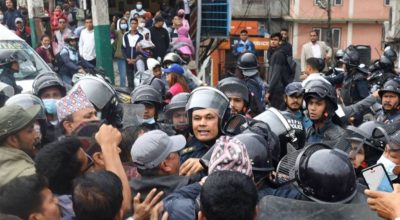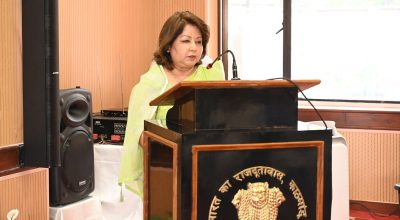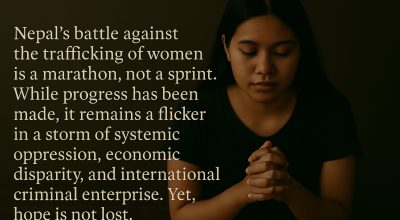
Human trafficking remains one of the most insidious violations of human rights in the 21st century—a clandestine enterprise fuelled by desperation, inequality, and exploitation. Among the countless victims worldwide, women and girls constitute a disproportionate share, particularly vulnerable to sexual exploitation, coerced labour, and domestic servitude.
Nepal, perched between two global giants—India and China—grapples with this crisis, functioning both as a source and transit nation for trafficked women. Despite growing international attention, the phenomenon continues to flourish in the shadows, nurtured by the country’s entrenched socio-economic disparities and systemic gender bias.
Nepal’s geography and porous borders have long facilitated trafficking routes, particularly to India, where open-border policies allow for easy, unmonitored movement. The Terai region, with its poverty-stricken districts like Bara, Parsa, and Makwanpur, has emerged as a breeding ground for trafficking agents who lure women with promises of employment and prosperity abroad. Destinations often include not only Indian cities like Mumbai and Delhi but also Gulf nations and Southeast Asian countries, where many are ultimately forced into brothels, domestic servitude, or sweatshop labour.
The roots of this crisis are deeply embedded in Nepal’s socio-economic fabric. Chronic poverty, especially in rural hinterlands such as Humla, Rukum, and Bajura, forces families into desperate decisions. For many, sending their daughters abroad seems like a gateway to survival.
Tragically, this vulnerability is ruthlessly exploited. A study by the Centre for Research on Environment Health and Population Activities (CREHPA) found that most trafficking victims hailed from households earning below the national poverty line, and many lacked formal education.
Gender-based discrimination compounds this vulnerability. In a society still largely governed by patriarchal norms, daughters are often undervalued and denied access to education and opportunities. According to a 2021 report by the National Human Rights Commission of Nepal, over 35,000 women and girls are trafficked every year—many of them teenagers lured through social media platforms or informal labour agents.
Cultural stigmas around survivors’ further silence victims and inhibit reintegration. Women rescued from trafficking often face societal ostracization, with their trauma dismissed or shamed. Such attitudes perpetuate the cycle of exploitation, pushing many backs into the hands of traffickers.
Legal frameworks do exist—the Human Trafficking and Transportation (Control) Act, 2007 criminalizes trafficking and provides for the rescue and rehabilitation of victims. However, enforcement remains inadequate. Law enforcement agencies are hampered by lack of training, poor inter-agency coordination, and, at times, complicity. Reports from watchdog organizations like Maiti Nepal and WOREC have exposed instances of police officials colluding with traffickers or failing to act decisively due to bureaucratic inertia.
Nevertheless, civil society in Nepal has been relentless. Organizations like Shakti Samuha—established by trafficking survivors—have pioneered rehabilitation programs that include vocational training, legal aid, and psychosocial counselling. Their grassroots approach, rooted in lived experience, has offered a blueprint for survivor-centered care.
Likewise, the National Committee for Controlling Human Trafficking (NCCHT) has made strides in policy advocacy, awareness campaigns, and cross-border collaboration.
Technological tools have also entered the battlefield. Initiatives such as the Hamro Samman Project (in partnership with USAID) have leveraged mobile technology and data-driven interventions to detect trafficking networks and monitor at-risk communities. Social media campaigns—like those led by the Nepal Police’s Cyber Bureau—have been instrumental in alerting youth to the deceptive tactics employed by traffickers.
However, these interventions, though commendable, face overwhelming odds. The emergence of organized transnational crime syndicates has complicated enforcement. These networks are agile, digitally savvy, and financially potent—exploiting legal loopholes and weak interstate cooperation to perpetuate their operations. Moreover, the COVID-19 pandemic and recent economic instability have pushed more families into financial precarity, increasing the pool of vulnerable individuals.
Moving forward, a robust response must be multi-pronged and sustained. Education, particularly for girls in remote regions, is not just a preventive measure but a tool of emancipation. Empowerment through education cultivates awareness, agency, and the capacity to resist coercion. Government programs like the Beti Bachau, Beti Padhau Abhiyan in India need to be expanded and better implemented to address educational disparities in Nepal as well.
Simultaneously, economic empowerment is critical. Microfinance initiatives and livelihood training programs targeting women, such as those run by the Women’s Foundation Nepal, have shown promising results. When women gain financial independence and self-worth, the seductive mirage of traffickers begins to fade.
Regional cooperation is another imperative. Bilateral efforts between Nepal and India, like the 2019 Memorandum of Understanding on Prevention of Human Trafficking, must be operationalized with clear mechanisms for information sharing, victim repatriation, and legal prosecution. The establishment of cross-border task forces and harmonized legal definitions could further enhance the fight against transnational trafficking networks.
Lastly, survivor reintegration must be treated not as an afterthought but as a foundational pillar of anti-trafficking policy. Psychosocial support, stigma reduction, skill-building, and long-term monitoring are essential to help survivors rebuild lives of dignity and resilience.
Nepal’s battle against the trafficking of women is a marathon, not a sprint. While progress has been made, it remains a flicker in a storm of systemic oppression, economic disparity, and international criminal enterprise. Yet, hope is not lost.
With bold policies, grassroots activism, regional cooperation, and unwavering commitment to human dignity, Nepal can unshackle the chains of trafficking. The women of Nepal deserve more than survival—they deserve justice, autonomy, and a future untainted by exploitation. #Nepal
The writer Sakar Mishra is currently a BSIT 1st year student studying in Presidential Graduate School
















